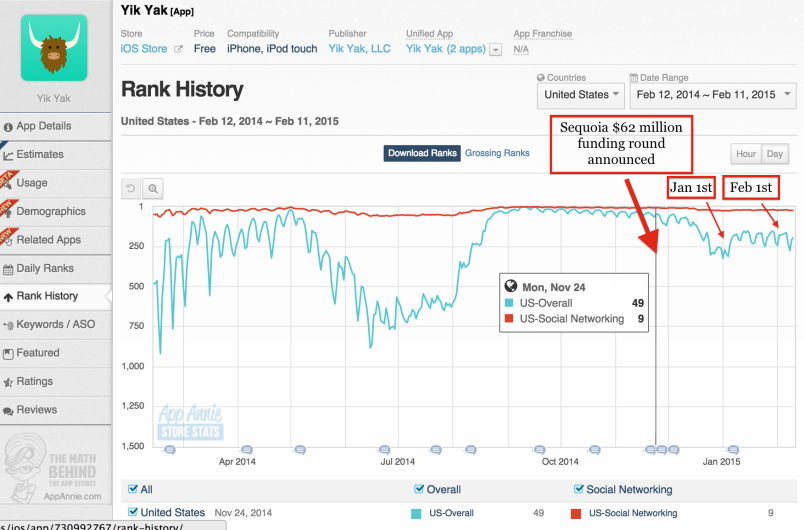Yik Yak, the app that’s becoming a social media staple on college campuses in the U.S., saw its downloads dip and flatline right around the time it announced its $62 million Sequoia funding round in December. It’s still early days for the young company, so what’s happening?
I pulled the stats from app analytics company App Annie and reached out to Comscore for the monthly active user (MAU) information. Yik Yak’s January MAUs aren’t available yet, but its October-December trajectory shows a similar trend as its download rankings. The number of people regularly on its app peaked and then started declining.
As always, it’s worth noting that Comscore on an individual basis underestimates user numbers, but for growth trends up or down it’s more accurate. It only shows data for people over the age of 18, but since the majority of Yik Yak’s users are college students that shouldn’t hugely impact its stats.

You might look at the data and think that the dip isn’t particularly dramatic compared to its previous drop in downloads after May 2014. But when you compare it to Snapchat, you see a big difference. Once Snapchat hit the top download ranks, it stayed there.

Could Yik Yak already be facing a Secret-like stagnation? Or is its growth pattern seasonal in a way other social media companies are not?
Social networking is a famously challenging industry to break into. Without the right network effects, social networking apps are useless for the people on them.
Yik Yak faces its own unique growth obstacle, which is also the point of its entire product: Hyperlocality. When you use the app, you only see the posts from people in a 1.5 mile radius from you. That doesn’t give you much incentive to get your friends in far-flung places on it, which in some ways limits the app’s growth.
That could be the reason for the current flatlining. Since the app is focusing on the college market in particular, its biggest growth happens when everyone returns home from school over summer and tells their high school friends about it. “It operates on a very cyclical nature,” Yik Yak co-founder Brooks Buffington told me when I asked about the growth slowing down.
Since Yik Yak has been around for less than a year, that explanation is a hypothesis, not necessarily fact. Without data from prior years we can’t fact-check it.
It also seems plausible that Yik Yak has saturated the university environment. It used to track its growth by how many college campuses it was on, but now it’s on every campus in the United States. Since the company hasn’t tried to cultivate its product in other communities, it makes sense its growth is stalling.
Despite that, the founders don’t want to work on expanding to new groups of people. “If we were concerned with just adding more bodies we would’ve left high schools open from the start,” Buffington said. Instead, they geofenced high school areas to block teens from using it after cyberbullying issues arose.
They have faith that for now grassroots growth, coming from the community itself, is more sustainable. They follow where their users take them. For example, they’re not actively marketing abroad, but when they see a college campus in the UK or Canada start to become active on the app, they reach out to the school to hire a student community manager of sorts.
“Facebook didn’t reach a billion users over night. They started somewhere and executed beautifully and were patient and focused on that,” co-founder Tyler Droll said. “We’re taking a page out of that book.”
The duo pointed out that despite the fact that they limited downloads in that way, their growth has still happened in an unusually fast manner. It took Snapchat almost two years to get to the upper echelons of download rankings, while Yik Yak took less than one year.
But to me that just raises a question of whether Yik Yak is a fad, one that grew rapidly but doesn’t necessarily have staying power.
“We’re not worried at all about it because we have this massive unparalleled foothold in the college market and the engagement with those users is off the charts,” Droll assured me.

